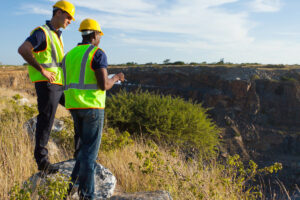You are given a hand compass and told to go off into this unknown territory and come back with a map and detailed drawings of the land. No GPS. No smartphone. No calls to mom. No helicopter to rescue you. It would be quite the feat! Many people today are used to the convenience and accuracy of GPS for navigation. If you drive into a new city, you likely use navigation tools to find the nearest burger place, hotel, or shopping center.
It wasn’t always like that. In fact, going into the unknown was part of this country’s early history. Somebody had to do it. That person (among others, of course) was Meriwether Lewis and William Clark when they set off West to map the unknown lands beyond the Mississippi River. This incredible history shows just how vast and expansive the United States was and is an inspiring real story of the American spirit on a tumultuous journey.
In past posts, we’ve explored the incredible technology that is changing and enhancing the work of land surveyors across the world. From drones to GPS to smart technology, mapping our world has improved through the implementation of these tools. We thought we’d go back in time to a story that had none of those technologies and surveyed over 8,000 miles with not much more than a pen, paper, and a whole lot of grit.
It Begins With the Son of a Surveyor and a Notable Name in American History
For most people, Thomas Jefferson is the name behind the Declaration of Independence and the third president of the United States of America. He is known as one of the most notable founding fathers who wrote and spoke eloquently about the role of government, led the revolutionary cause, and worked for the republic moving forward. A little unknown fact about Jefferson is that he was a son of a land surveyor and a land surveyor himself. He was exposed to the world of mapping and charting as a young boy and for a time considered pursuing this as his profession. Because of his exposure to the line of work, Jefferson understood the importance and necessity of having accurate maps and surveys of one’s country. He knew that a new nation attempting to build itself could not do without the knowledge of its own lands.
As president, Jefferson emphasized the importance of the landowner and the central role they played in building the country. All of this fueled his ambitions for discovery and exploration, as well as an understanding of what lay beyond the recent territories the country had just acquired.
The Louisiana Purchase obtained after a negotiation had added 827,000 square miles to the United States. This was a lot of unexplored territories. Jefferson was already calling for it to be surveyed. He appointed his secretary, Meriwether Lewis, a known surveyor as well, to lead the expedition. Lewis would choose his friend William Clark and together they would put together a team that would change American history and set an example for pioneers everywhere.
The Two Men That Would Spearhead the Corps of Discovery
Like many early pioneers, William Clark and Meriwether Lewis were men of their era: smart, with a drive for adventure, and a relentless spirit. Lewis went to college in his home state of Virginia and graduated in 1793, no small feat at the time. He joined the Virginia state militia and took part in putting a stop to the Whiskey Rebellion. He would go on to become captain of the U.S Army, and at the ripe age of 27, he became a personal secretary to the President of the United States, Thomas Jefferson.
William Clark joined the state militia of Kentucky when he was nineteen and would go on to serve in the regular Army. He served with his future partner Lewis and would be commanded by George Washington himself as a lieutenant of infantry.
Survey Instruments Used For the Treacherous Expedition
It might be interesting to note that Thomas Jefferson taught Lewis the basic principles of determining latitude by observing altitudes of the sun or a star with an octant. Both Lewis and Clark understood that this was not a journey to take lightly. Both prepared adequately for the journey Jefferson also sent him for formal education and once appointed to head the expedition, Lewis began studying medicine, botany, astronomy, and zoology. He would study and analyze existing maps and journals. Some of the surveying tools they had at the time included:
- Compass
- Quadrants
- Telescopes
- Sextants
- Chronometer
- Tape measure
- Thermometers
- Plotting instruments
Soon, this dynamic duo would set out for the unexplored wildlands of the West. In Part II, we’ll explore their journey, what they ran into, and what they found after miles and miles of exploration, map-making, surveying, and endless adventure.
Here at Land-Mark professional surveying, we have slightly more sophisticated equipment than Lewis and Clark, but we see every job as an adventure. For a professional land survey, contact Land-Mark today.

